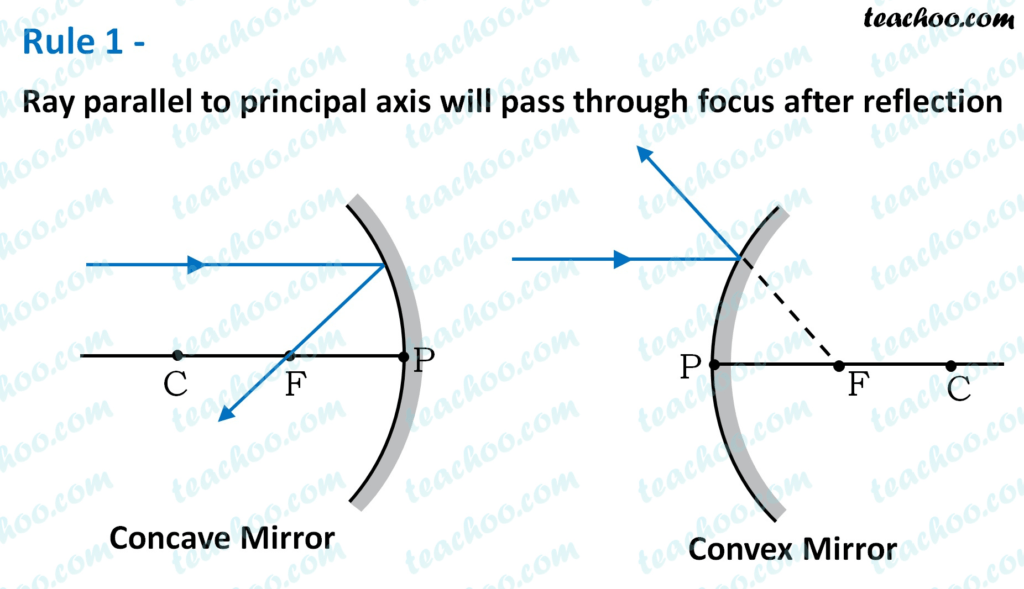A concave mirror has the property of conserving object distance. A virtual image is formed when light strikes the concave mirror, and an upright image is formed when it strikes a convex mirror. Rules for image formation by concave mirror can be listed as follows:
In image formation by a concave mirror, the object is placed farther away from the center of curvature of the mirror as compared to its focal length. The image is always virtual and larger than the object.
A concave mirror forms a real image behind the mirror. 2. The larger the radius of curvature, the more distant is the image. 3. The further apart two objects in space, the farther apart their images will be formed by a concave mirror. 4. An object seen through a concave mirror appears smaller than normal size because of magnification by reflection and because of the convex nature of the mirror surface below its center as well as above its focal point. 5. An upright concave mirror magnifies an object vertically but has no effect on its horizontal dimensions, hence doubling its vertical size while leaving it unchanged in length and width
rules for image formation by concave mirror

Concave Mirror
Is defined as a spherical mirror with a polished inner side.
Definitions of Special terms
1
Center of Curvature:
is the center of the hollow spherical mirror. Its radius is called the radius of curvature.It should be noted that the center of curvature (denoted by ‘C’) of a concave mirror is in front of the mirror whereas that of a convex mirror is behind the mirror.
Concave Mirrors 35467.jpg
2
Pole:
The geometric center of a spherical mirror is called pole or vertex. It is denoted by ‘P’.
3
Aperture:
is the distance between the extreme points (MM’) of the mirror OR The diameter of the mirror.
4
Principal Axis:
The straight line passing through the pole ‘P’ and the center of curvature ‘C’ is called the principal axis. AB is the principal axis in the fig.
5
Concave mirrors:
converge to a point, called the principal focus, that is denoted by ‘F’.
6
Focal Length:
The distance between pole ‘P’ and the principal focus ‘F’ is called focal length. It is denoted by ‘f’. It is equal to half the radius of curvature. f = r/2 The focal length of a concave mirror is considered as positive.
Rules for Obtaining Images Formed by a Concave Mirror
When an object is placed in front of a concave mirror, an image is formed. The point of intersection of any of the two rays shows the image point “I” of object “O”. The rays which are reflected from a concave mirror follow certain rules as under.
1
A ray coming parallel to the principal axis is reflected through the principal focus of the concave mirror.
2
The ray of light passing the principal focus becomes parallel to the principal axis after being reflected from the mirror.
Concave Mirrors 97965.jpg
3
A ray of light which is coming through the center of curvature is reflected back along the same path.
Concave Mirrors 83179.jpg
4
A ray of light incident on the pole, at an angle “O” with the principal axis, is reflected by the same angle “O”.
Concave Mirrors 56953.jpg
IMAGE FORMATION BY CONCAVE MIRROR
The type of images formed by a concave mirror depends on the position of the object to the mirror. If the distance of an object say OO’ from a concave mirror is changed, then the nature, size, and location of the image are also changed.
Formation of different images depending on the position of the object are shown below:.
1
First Position:
(Beyond ‘C’). When the object is placed beyond the center of curvature C, then the image will be formed between the focus and the center of curvature; between ‘F’ and ‘C’. This image will be real, inverted and smaller in size.
Concave Mirrors 48651.jpg
2
Second Position:
(at ‘C’). When the object is placed at the center of curvature. The image is formed at the center of curvature C and is real, inverted and equal in size.
Concave Mirrors 45961.jpg
3
Third Position:
(Between ‘C’ and ‘F’). When the object is placed between the center of curvature C and focus F, then the image formed will be beyond C. This image will be real, inverted and larger than the object.
Concave Mirrors 27264.jpg
4
Fourth Position:
(at ‘F’). When the object is placed at the principal focus, then the image will be real, inverted, larger and at infinity.
Concave Mirrors 19406.jpg
5
Fifth Position:
(between ‘F’ and ‘P’). When the object is placed between the pole and principal focus, then virtual, erect and larger image will be formed.
Concave Mirrors 26755.jpg